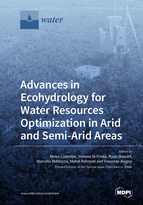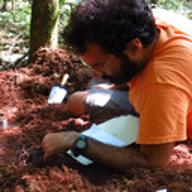Advances in Ecohydrology for Water Resources Optimization in Arid and Semi-arid Areas
A special issue of Water (ISSN 2073-4441). This special issue belongs to the section "Ecohydrology".
Deadline for manuscript submissions: closed (15 January 2022) | Viewed by 30377
Special Issue Editors
Interests: soil hydraulic conductivity; soil water retention; soil physical quality; soil management; soil conditioners
Special Issues, Collections and Topics in MDPI journals
Interests: soil hydrology
Special Issues, Collections and Topics in MDPI journals
Interests: soil hydrology; engineering; agriculture; urban systems
Interests: soil degradation; soil and water conservation
Special Issues, Collections and Topics in MDPI journals
Interests: soil physics and conservation; sustainable management; Vadose zone hydrology
Special Issue Information
Dear Colleagues,
Conserving water resources is current challenge that will become increasingly urgent in future years due to climate change. The arid and semi-arid areas of the globe are expected to be particularly affected by changing water availability. Consequently, advances in ecohydrology sciences (i.e., the interplay between ecological and hydrological processes) are necessary to enhance the understanding of the critical zone hydrology, to optimize water resources usage in arid and semi-arid areas, and mitigate climate change.
This Special Issue aims to investigate the relationships between hydrological and ecological processes and how these interactions can contribute to the optimization of the water resources in arid and semi-arid areas. Similarly, evaluating water management options and testing new experimental procedures in these areas are essential to produce robust water savings.
Hydrology and water resources should be prevalent aspects of submitted investigations. Submissions will address one or more of the following issues, with closely related topics also welcome:
- Ecohydrology processes and their relationships with drought, aridity, and water scarcity
- Impact of hydrology changes on ecosystems degradation
- Effects of land or soil use changes on components of the hydrological cycle (runoff, recharge, etc.)
- Modelling applications for predicting climate or soil land use change effects on water availability
- Soil use and management of arid and semi-arid environments
- Soil physical and hydraulic properties changes of arid and semi-arid environments
- Soil properties governing hydrological processes
- Innovative methods and technologies for monitoring ecological, hydrological, and soil processes
- Relationships between microflora and microfauna and physical and hydraulic indicators of the soil
- Impact of biological crusts on soil properties
- Role of hydraulic redistribution in water availability and ecosystem function
- Effects of treated wastewater usage on soil hydraulic properties
Theoretical, methodological, and case studies, as well as review papers, are welcome.
Dr. Mirko Castellini
Dr. Simone Di Prima
Dr. Ryan Stewart
Dr. Marcella Biddoccu
Dr. Mehdi Rahmati
Dr. Vincenzo Alagna
Guest Editors
Manuscript Submission Information
Manuscripts should be submitted online at www.mdpi.com by registering and logging in to this website. Once you are registered, click here to go to the submission form. Manuscripts can be submitted until the deadline. All submissions that pass pre-check are peer-reviewed. Accepted papers will be published continuously in the journal (as soon as accepted) and will be listed together on the special issue website. Research articles, review articles as well as short communications are invited. For planned papers, a title and short abstract (about 100 words) can be sent to the Editorial Office for announcement on this website.
Submitted manuscripts should not have been published previously, nor be under consideration for publication elsewhere (except conference proceedings papers). All manuscripts are thoroughly refereed through a single-blind peer-review process. A guide for authors and other relevant information for submission of manuscripts is available on the Instructions for Authors page. Water is an international peer-reviewed open access semimonthly journal published by MDPI.
Please visit the Instructions for Authors page before submitting a manuscript. The Article Processing Charge (APC) for publication in this open access journal is 2600 CHF (Swiss Francs). Submitted papers should be well formatted and use good English. Authors may use MDPI's English editing service prior to publication or during author revisions.
Keywords
- Ecohydrology
- Critical zone hydrology
- Soil hydrology
- Soil degradation
- Soil biodiversity
- Water conservation
- Hydrological processes
- Arid and semi-arid areas











